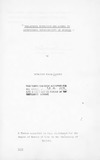| dc.description.abstract | This is an exploratory study of nursery
education in Nairobi. The main aim is to classify
the types of nursery schools which exist and identify
their social significance. Although research in
the Sociology of Education has focussed primarily
on the relationship of the formal education system
to the social and economic context, little
attention has been paid to the tole of nursery
education. To fill this gap this study investigates:
(a) the significance of nursery education in
relation to the rest of the formal school system
particularly its role in regulating access to the
primary education, and (b) its contribution
to the process of social stratification. The
nursery schools in the study area - Nairobi - can
be divided into clear categories which formed the
basis of the sampling strategy used in the study.
The nursery school is the unit of analysis and
the nursery school principal the key respondent.
A central assumption of this study is that
inequality in the distribution of educational
opportugities is a reflec.tion of the general
inequalities found among social groups.
Survey data from nursery schools in
Nairobi, an urban area in Kenya, are used to
determine whether the same relationships which
have been found between education and the social
group structure in other societies exist in Kenya.
Hence, the study investigates the extent to which
the differentiated structure and content of
education is related to the social class structure
as indicated by the major independent variables
i.e. cost, geographical location and race of the
school principal. Other determinants such as
nursery school ownership are also examined in
the study.
The major findings emerging from the Nairobi
data show that the development of nursery education
has taken a pattern that parallels the structure
of primary education. For example, there is a
very high correlation between the.'fees charged in
nursery schools and the type of primary schools
entered. In other words, the children who graduate
from the expensive nursery schools go to the high-
cost primary schools while the graduates from low
cost nursery schools go to the low-cost primary
schools. It was also found that nursery schools
differ in the-use of language, allocation of time
on various aspects of the curriculum and in the
headteachers' perception of the personality traits
children are encouraged to develop. The observed
differences in the use of language show that children
from privileged social backgrounds have disproportionate
access to nursery schools emphasizing
English language which in turn contributes to
their educational mobility. The differences in
the allocation of time indicate that the low-cost
nursery schools spend more time in teaching
literacy and numeracy than the expensive schools.
The latter are more responsive to the creative
and aesthetic needs of the child.
The empirical. findings support the central
thesis of this study that nursery education
has unequal outcomes both in the type of primary
schools entered and in the content of education
received. However, these outcomes are to a large
extent a reflection of the inequality among the
social classes that are served by these nursery
schools. In order to give every child an equal
opportunity to develop their personal potentialities, it is st rongly recommended that the material wealth
and services must be more equitably distributed in
the society. It is only after the poor are liberated
from the struggle to satisfy the basic needs: food,
shelter, clothing and good health that their human
potentialitiescan be fully realized. | en |

